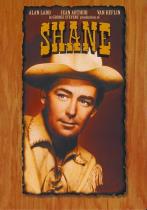Shane
 Year:
Year: 1953
Film Studio: Paramount Pictures
Genre: Western, Classic
Length: 118 Min.
DirectorGeorge Stevens (1904)
WritingA. B. Guthrie Jr. (1901)...Screenplay
Jack Sher (1913)...Additional Dialogue
Jack Schaefer (1907)...Novel
ProducerIvan Moffat (1918)
George Stevens (1904)
CinematographerLoyal Griggs (1906)
MusicVictor Young (1899)...Composer
StarsAlan Ladd (1913) as Shane
Jean Arthur (1900) as Marian Starrett
Van Heflin (1910) as Joe Starrett
Brandon De Wilde (1942) as Joey Starrett
Jack Palance (1919) as Jack Wilson
Ben Johnson (1918) as Chris Calloway
Edgar Buchanan (1903) as Fred Lewis
Emile Meyer (1910) as Rufus Ryker
Review Hollywood cranked out hundreds of Westerns in the 30’s, 40’s and 50’s; mostly B pictures that filled the bill on double features for an endless army of kids who spent their weekends imagining themselves as Billy the kid, Jesse James and Wyatt Earp in the
‘Old West’. What all of these films had in common was that they were all long on action, but short on storyline. Clichéd plots which had been recycled time after time had proven to studio chiefs that if it wasn’t broke, don’t fix it. In 1953, director George Stevens would take the simplest of plots, ranchers versus pioneers, and create a visual masterpiece that would define the
‘Epic’ Western for the next two decades. What would elevate the plot from B movie fodder to magnificent masterpiece was the gorgeous cinematography, along with bravura acting performances from the cast of this seminal Western. Alan Ladd had appeared mostly in film noir, but would find a new career in the Western genre. Although short in stature, he was long on talent and imbued the main character with a coolness and grace that would make the lone wandering rider Shane, one of the great iconic heroes of cinematic history.
It is a few years after the Civil War and as pioneers are settling homesteads across the Great Plains; the ranchers who have been ranging their cattle on the vast landscape are being fenced off from the vital water supplies that sustain their herds. Joe Starrett’s (Van Heflin) family is one of a handful of
‘sodbusters’ that have come to live and homestead a piece of the plains in frontier Wyoming. Starrett’s dream of a new life for himself and his family stand in the way of a grizzled old rancher named Ryker (Emile Meyer), who has been raising longhorns on the plains since the days when it had been an untamed wilderness. With the ever increasing amount of pioneers coming to this part of the country to settle, Ryker decides that heavier handed methods are needed to remove them from his shrinking holdings. One day, into this harrowed landscape rides Shane (Ladd), a soft mannered stranger who at first is mistaken for one of Ryker’s henchmen. After standing alongside Starrett in a small confrontation with the real ruffians, he is offered a job and a home with the Starretts. At first, the homesteaders and the ranchers don’t know what to make of the new hired hand, but in the end they will find out that Shane is a man akin to Teddy Roosevelt’s adage
“Speak softly and carry a big stick”.
As I mentioned earlier, part of what made this film so successful was Steven’s grand cinematography of the Wyoming wilderness, which served as the backdrop for this frontier saga. At times it seems as if you are looking at a color version of an Ansel Adams photograph of the majestic Grand Teton mountain range. I have seen these mountains and Steven’s rendering on film would make any artist proud. It’s sad that this film wasn’t made in 1954, so as to take advantage of the new Cinemascope widescreen film process that would soon be the standard used in Hollywood.
Shane would be the swan song for the everlastingly radiant Jean Arthur; she had started acting in silent films and had been one of the top performers of the thirties and forties. After making
Shane, she would retire with a brilliant résumé of accomplished performances in some of the greatest films of all time. She was a consummate professional and has always been one of my favorite actresses.
Ratings Criterion5 Stars - The pinnacle of film perfection and excellence.
4 ½ Stars - Not quite an immortal film, yet a masterpiece in its own right.
4 Stars - Historically important film, considered a classic.3 ½ Stars - An entertaining film that’s fun or engaging to watch.
3 Stars – A good film that’s worth a Netflix venture.
2 ½ Stars - Borderline viewable.
2 Stars – A bad film that may have a moment of interest.
1 ½ Stars – Insipid, trite and sophomoric, and that's its good points.
1 Star – A film so vacuous, it will suck 2 hours from the remainder of your life.
½ Star - A gangrenous and festering pustule in the chronicles of celluloid.